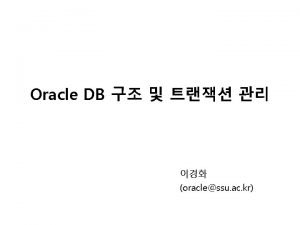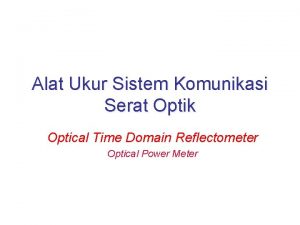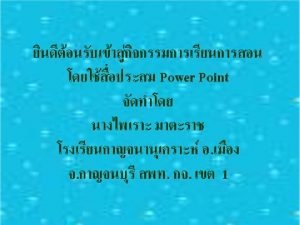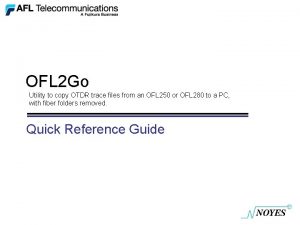OTDR Studies First look with SM OTDR failed











- Slides: 11

OTDR Studies • First look with SM OTDR failed: not enough sensitivity to see RBS signal. • Nice clear signals visible with MM OTDR (on free loan until 11/05/07). • Next slides show typical traces – RBS signal clearly visible above noise floor can measure attenuation length of fibre in cable with laser at 856 nm – Higher resolution with 665 nm laser allows clear separation of the Fresnel peaks from the MT-12 at PPB 1 and the p-i-n diode on the dogleg. 1

OTDR Measurements APC ST MT MT MM v OTDR 3. 2 m or 2 m 5 m MT p-i-n diode ~ 2 m FUT (Fibre under test) 2

Connectors at start of cable and fan-out RBS Signal above background MT-12 at PPB 1 p-i-n diode on dogleg 3

Use delay setting to avoid peaks from start of cable & fan-out 4

Use 665 nm laser for higher resolution to see loss at MT 12 at PPB 1 5

Use 856 nm laser to measure attenuation length of fibre in cable 6

Measurements • Measured attenuation length of fibres in cable and loss at MT-12 at PPB 1 for – All fibres in 4 ribbons associated with “problematic” channels, all channels have < 90 m. A p-i-n current. – All fibres in 4 ribbons associated with “good” channels. All channels have >= 90 m. A p-i-n current. • Also checked that there was no excess loss near PPB 1 due to micro-bending. • Measured attenuation length of 4 ribbons in spare cable. 7

Summary • Attenuation lengths – <good channels> = 15. 1 +/- 0. 45 d. B/km – <bad channels> = 17. 1 +/- 0. 6 d. B/km – <fibres spare cable> = 8. 24 +/- 0. 28 d. B/km • Loss at MT-12 PPB 1 – <good channels> = 0. 13 +/- 0. 02 d. B – <bad channels> = 0. 17 +/- 0. 03 d. B 8

Discussion • There are systematic errors on the absolute values of these measurements but the relative measurements of good and problematic channels should be meaningful. • Losses at PPB 1 appear to be very small and no significant difference between problematic and good channels. • The attenuation length for problematic channels is slightly longer than for good channels. Marginally statistically significant (2. 7 s) • Attenuation length for fibes in spare cables is significantly longer. 9

Averages for ribbons • Look at average attenuation lengths for each ribbon • Good Crate/slot/Tx • Problematic • Spare Attenuation d. B/km Error 080 10. 55 0. 35 2 14 1 15. 06 0. 54 171 17. 58 0. 32 3 15 0 17. 14 0. 27 Crate/slot/Tx Attenuation d. B/km Error 060 15. 38 0. 60 070 12. 71 1. 34 2 12 0 18. 83 0. 15 2 12 1 21. 63 0. 50 10

Conclusions • Some evidence for non-statistical ribbon to ribbon variations. • Difference between “good” and “problematic” ribbons small, even for worst ribbon – extra attenuation compared to good ribbons is only ~ 0. 6 d. B. – For this ribbon <Expected/measured pin current> = 5. 9 d. B • Difference between fibre in spare cable and fibres in installed cables is much larger. • Different mode coupling for fibres in installed cables compared to fibres in spare cable ? ? ? • Still need “better” VCSELs … 11
 Look down look up
Look down look up Failed to execute 'fetch' on 'window': failed to parse url
Failed to execute 'fetch' on 'window': failed to parse url Macro bending losses in optical fiber
Macro bending losses in optical fiber Cara kerja otdr
Cara kerja otdr Famous people who failed at first
Famous people who failed at first Paradigm shift from women studies to gender studies
Paradigm shift from women studies to gender studies Look at the image in activity 1
Look at the image in activity 1 What's in activity 1 looking back
What's in activity 1 looking back Activity 1 a look at the picture
Activity 1 a look at the picture Has modernism failed
Has modernism failed If you had studied hard you would have succeeded
If you had studied hard you would have succeeded Looked but failed to see accidents
Looked but failed to see accidents



















